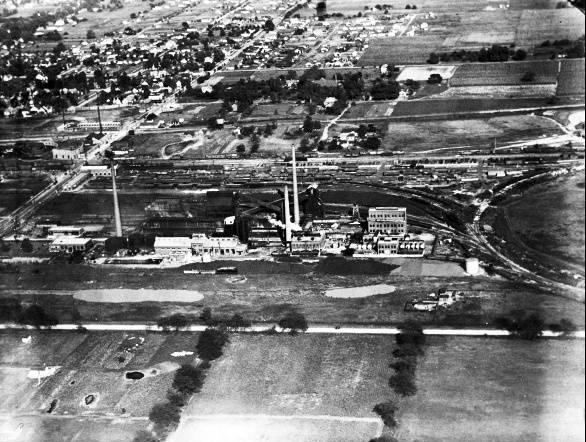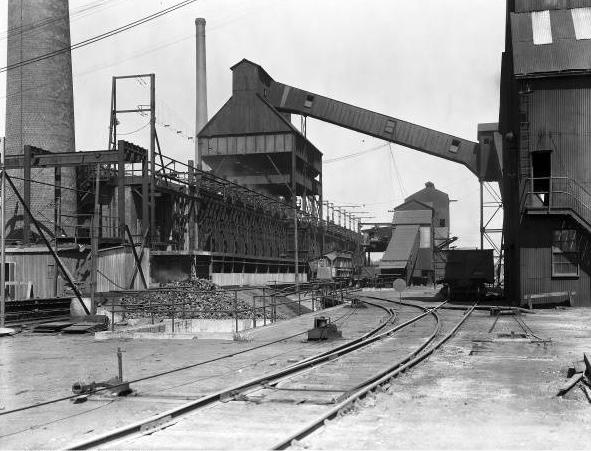Indiana Gas began as the Indiana Gas & Water Company, which was formed in September 1945 from the natural gas and water divisions of its parent company Interstate Public Utilities, later known as . It was forced to divest itself of its gas and water subsidiaries to comply with the Public Utilities Holding Company Act of 1935.

Indiana Gas Company, however, traces its origins to the coal gas era in Indiana. Early predecessors provided manufactured gas to Lafayette (1852) and Terre Haute (1856). Most Indiana cities in the latter half of the 19th century had manufactured gas (also called town gas) plants, and the predecessors of Indiana Gas provided service to communities in the central and southern parts of the state. The discovery of natural gas in the area northeast of Indianapolis during the 1880s created a natural gas distribution industry in the state for 30 years prior to the development of the industry elsewhere in the country. The shallow Indiana wells, however, went dry shortly after the turn of the century, and the industry returned to a mixture of natural gas from Appalachia and manufactured gas.
By 1912, the predecessors of Indiana Gas had been organized in the gas division of the Interstate Public Service Company. Interstate operated the interurban electric railway between Indianapolis and Louisville and was a subsidiary of the Chicago-based Middle West Utilities, part of the utility empire of British-born American entrepreneur Samuel Insull. Insull bought up small-town electric and gas utilities across the Midwest and contributed to the creation of integrated electrical infrastructure in the U.S.

Interstate Public Service was headquartered in the at Market and Illinois streets. When the first natural gas pipeline from the Kansas and Texas Panhandle gas fields entered Indiana in 1931, the holding company began converting many of its towns to natural gas. The Insull empire, however, was a casualty of the Great Depression, entering bankruptcy in 1932, and Middle West Utilities subsequently was forced into receivership.
The divested Interstate Public Service water and gas divisions combined in 1945 to form Indiana Gas & Water, with the new utility providing gas to over 60,000 customers in southern, central, and central-northern Indiana communities. A dated gas distribution system was unable to handle the increased demand, and to alleviate this problem, Indiana Gas & Water began a program in 1946 to lay 60 miles of gas line. In 1947, it built a transmission line connecting to a major pipeline operated by the Texas Eastern Gas Transmission Corporation. The company also installed several liquefied petroleum gas plants.
By the late 1950s, the discovery of new sources of natural gas throughout the United States ended a gas shortage and caused an industry boom. At this point, Indiana Gas & Water had already begun selling off its water utilities and redirecting its funds towards new natural gas storage facilities. The company also nearly tripled the amount of gas it purchased from its suppliers by 1961.
Throughout the early 1960s, Indiana Gas & Water expanded its service territory dramatically, adding over 20 new communities through the acquisition of four gas utility companies. The company also made gas utilities its focus and sold what remained of its water utilities. As a result, the company’s name was changed to Indiana Gas Company.
A fuel shortage once again befell the gas industry in the 1970s. Federal regulation of natural gas prices made it difficult for companies to raise enough money from gas sales to fund exploration and drilling. The shortages affected Indiana Gas Company, which was forced to ration its supply to customers. The company also managed the shortages by building propane storage where it could mix propane with air to produce a gas similar in quality to natural gas.
Indiana Gas Company made a major move to expand. In 1976, the company purchased the Muncie-based Central Indiana Gas Company. This acquisition made Indiana Gas Company the second-largest gas utility in Indiana, serving nearly 300,000 customers throughout the state.
From 1978 through 1983, Indiana Gas Company raised its rates multiple times due to the rapid rate increase from its suppliers, which was at times was much as 40 percent. After 1983, gas prices finally began dropping allowing Indiana Gas Company to cease rationing gas to its customers and to lower rates.
Through the 1980s and 1990s, Indiana Gas Company put into motion several organizational changes. In 1985, Indiana Energy, Inc. was formed as a holding company for Indiana Gas Company. Other changes throughout the 1980s included centralizing materials distribution and dispatching to the Indianapolis warehouse, consolidating commercial officers into six regional offices, reorganizing meter-reading routes, becoming customer focused, and changing the management approach to include more employee participation.
In 1990, the company acquired the Richmond Gas Corporation and Terre Haute Gas, expanding its territory to cover 48 counties throughout the lower two-thirds of the state and increasing its customer base to nearly 400,000. The company also formed IEI Investments, Inc. to be able to move into business ventures outside of gas distribution.
Throughout the late 1990s, IEI Investments formed several alliances with subsidiaries of Citizens Gas and Coke Utility (now ) to obtain better prices and use of resources for both companies, including ProLiance Energy (1996), CIGMA (1997), and Energy Systems Group (1997). Energy efficiency and operational performance were the aims of these moves.
In 1998, IEI divided into separate business units: Indiana Gas, IEI Investments, and IEI Services—the company’s administrative arm. This same year, the company embarked on its new growth strategy plan. Under this 5-year plan, IEI aimed to become a leading energy provider by increasing its earnings while also reducing costs. To achieve this goal, the company reduced its number of employees and disposed of various assets.
In 2000, Indiana Gas (under IEI) merged with Southern Indiana Gas and Electric Company (SIGECO) to form Vectren in an effort to grow and provide more services at better prices to its customers. The two companies maintained their separate utilities while serving as Vectren’s operating companies. In 2010, Indiana Gas was renamed Vectren North, and SIGECO was renamed Vectren South.

Help improve this entry
Contribute information, offer corrections, suggest images.
You can also recommend new entries related to this topic.